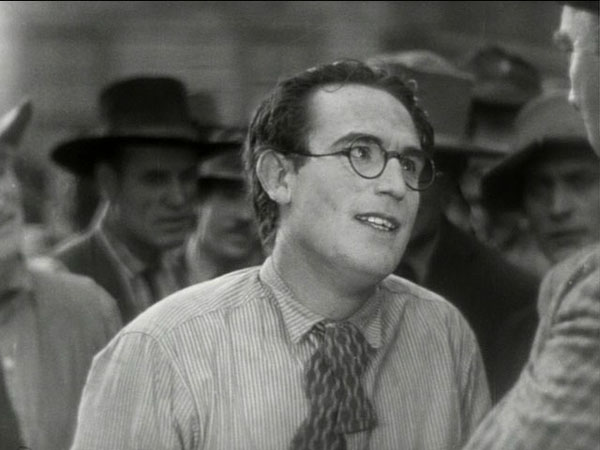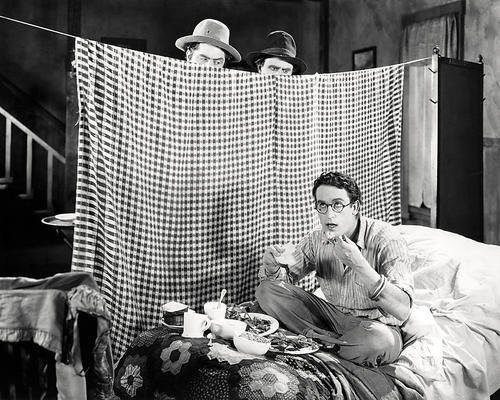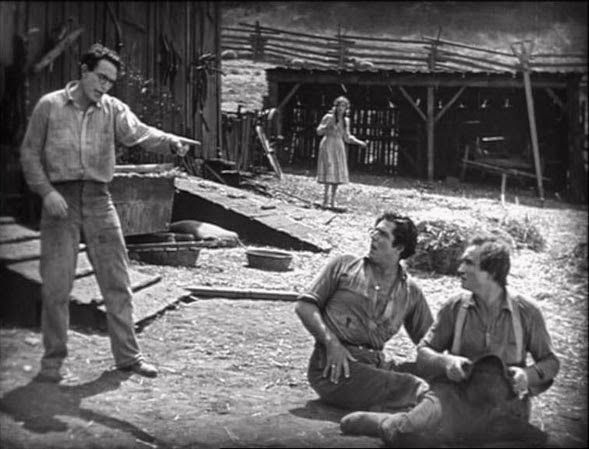Harold Lloyd Opens 2018/19 Duck Soup Cinema Season In His 125th Birth Year
The 2018/19 Duck Soup Cinema series premiered in Overture Center’s Capitol Theatre with two showings of Harold Lloyd’s 1927 masterpiece The Kid Brother. Coinciding with the 125th anniversary of Lloyd’s April 1893 birth, the fullest expression of the comedian’s glasses-mannered and gag-driven screen persona returned attendees to the rural America milieu of his midwestern childhood for a comic-naturalist cameo-view of the days of horse buggies, medicine shows, and barnyard chores. Per its title, the youngest and frailest branch of the hardened Hickory family tree, played by Lloyd himself, must overcome his perceived shortcomings – brains over brawn – to prove himself worthy of his own name.

Entering the Capitol Theatre for the matinee show, Doc the Rube and Dan the Magic Man performed welcome and welcoming balloon sculptures and card-drawing sleight-of-hand on either side of the ground-level lobby. Shown to one’s seat, the theater’s Grand Barton Organ provided entrance music as played by returning organist Clark Wilson. One had a few moments to register Broadway and pop hits emanating from the surround-sonic sphere of the basement-to-rafters installation of pipes, whistles, chimes, and bells before host Joe Thompson stepped enthusiastically from behind the curtain to get the “show” part of the show going.
The vaudeville portion of the program was kicked off by tuba, trombone, trumpet, drums, and sax(es) combo The Brass Tacks, who dug heavily into a medley of pep band-inflected pop music hits from the 1960s through the 1980s. Hailing from this audience member’s alma mater, Monona Grove High School, one was gratified to see and hear residual evidence of the school’s successful band program 20-odd years beyond graduation. A returning Ken Lonnquist entertained as always with his folksy performance of guitar-strumming humor. Ranging on song-topics from Autumn-metaphor forest fires to the seasonal torture of pumpkins – ending with a calypso-tinged Public Service Announcement on the perils of tobacco – this Madison and Midwest-mainstay is a perennial performing delight. Rounding out the program, tap dancer Katherine Kramer – accompanied by two student dancers – performed elegantly to Harlem and Cotton Club recordings with Bill “Bojangles” Robinson-inspired steps from New York City’s Jazz Age. (Rather a perfect preface, one might add, to a contemporary movie showing from 1927.)

Leaning back into the “perfumed twilight” provided by organist Clark Wilson and his feature-length Grand Barton accompaniment to Harold Lloyd’s The Kid Brother, a score including a rousing selection and expressive arrangement of traditional American folk-songs, the 35 mm projection of this late-silent era comedy classic remains involving from frame 1. Set in an off-trail frontier town in the last decade of the 19th century, the title character, Harold Hickory (Lloyd), is the youngest and scrawniest son of the widowed town sheriff (Walter James), left home to cook and clean for the family as his hulking older brothers (Leo Willis, Olin Francis) work for their father as sheriff’s deputies.
The uneasy tranquility of the rural community is disturbed by the arrival of a traveling medicine show, whose proprietor, “Flash” Farrell (Eddie Boland), and strong-man partner, Sandoni (the menacing Constantine Romanoff), are on felonious lookout for any fleecing opportunities of the gullible townspeople. Extending to their exploitation of innocent accompanying dancer Mary Powers (Jobyna Ralston), their illegal act is eventually broken up in hysterically unintentional fashion by meekly ineffectual Harold during an unlicensed town festival.
As the deceitful duo plot their revenge, Mary accompanies Harold after the affair’s fiery destructive aftermath to the (relative) safety of the Hickory homestead. While the Hickory brothers embroil themselves in a prolonged comic struggle of unaccustomed delicacy over the arrival of Mary, the miscreant pair of Flash and Sandoni make off with a thousand-dollars entrusted to Sheriff Hickory for the construction of the town’s dam. Harold cannily follows the trail of the outlaws to an abandoned ship on the town’s overflowing river-bed even as the townspeople prepare a rope for his embattled father.

Building inexorably to the triumphant paternal approval articulated in the film’s thematically climactic screen intertitle – “Son, you’re a real Hickory” – there is little suspense in the film’s faultlessly-constructed and character-developing plotline that Harold Hickory will ultimately succeed. Rather, it is the “how” nature of that narrative formula that provides the comic-dramatic impulse of the story’s continuously-building, forward-propulsion through 8 plot- and action-packed reels. Transcending obstacles of space, time, manners, and disposition, the classic Lloyd “glasses” persona invites underdog identification even as his astonishing personality ingeniously triumphs at every story-turn.
Although relegated to housework, fulfilling the role of the absent mother, Harold (by name alone showing the classic Hollywood story convention of a character being inseparable in an audience’s view from the star) ingeniously fashions a wind- and kite-powered clothes-washing machine in his character’s introduction, and later spin-cleans a net-full of dishes, neatly stacking them on a detachable board above a lit-stove to dry (sweeping efficiently in the meantime) before replacing the ready-made shelf to its flawlessly washed, dried, and arranged place over the kitchen cabinet. A human model of quick thought and efficiency, the bashful façade (look closely and you’ll notice there are no glasses in those glasses) conceals the most capable of characters imaginable, whose quickly shifting expressions of fear, embarrassment, surprise, and plain goofiness continually bely the quickest of wits – hiding his glowing face and lean frame behind a sunflower and its stalk one moment and fashioning a girlish back-frock to the tail-end of a goat the next – and the staunchest of souls.
True character comes from within, of course, and Harold’s shines through every dark encounter with screen villainy up to and exceeding that of towering brute Sandoni. Possibly the funniest moment in the film is when Sandoni, during the breathless sequence aboard the ghost ship, at one point bashes a lead pipe repeatedly over poor Harold’s head; only for it to be revealed – as the bent pipe is drawn away in astonishment from the latter’s apparently brass skull – that Harold had last-second positioned his head directly beneath a steel hook attached to the ship hull. In contrast, possibly the most harrowing moment in the film is when the townspeople, after shortsightedly blaming Sheriff Hickory for the money’s loss, parade the blameless official down the town’s thoroughfare; and just as the marching unrest threatens to turn into a lynch mob – with a crowd member fingering a rope and leading a detour away from the town jail towards a makeshift tree branch-gallows – Harold pulls to a two horse-driven halt with both the stolen money and its multiple inner tubes-incapacitated thief. That this now-Herculean figure of quick thought and inventiveness had just knocked the latter senseless with a quick side-route under a low-hanging, thick-solid branch once again shows brains – in this case, story-definitively – triumphing over brawn.

In romance, conflict, and daunting challenge alike, the Harold Lloyd “glasses” character evokes that can-do, uniquely American spirit of pluck and resolve. So too does a midwestern silent movie program relying on an over 90-year-old performance venue with period-contemporary technology and artistry. In its 19th century setting, The Kid Brother shows the future’s triumph over past adversity that will result in the American century of the 20th; one feels in watching that Harold Hickory will one day be building the dam that will point his frontier town through the rocky country roads towards future progress. Likewise, in our own 21st century challenges, the careful preservation of cultural artifacts of the past may enrich our own present, and perhaps the 125th anniversary spirit of a Harold Lloyd can ultimately provide much-needed reassurance for those viewers carefully considering the obstacles of an uncertain future.

